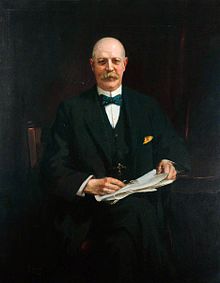Charles John Bowen Cooke | |
|---|---|
 by James Peter Quinn (1869–1951) | |
| Born | 11 January 1859 Orton Longueville, Huntingdonshire, England |
| Died | 18 October 1920 (aged 61) Falmouth, Cornwall,[1] England |
| Nationality | English |
| Citizenship | British |
| Occupation | Engineer |
| Engineering career | |
| Discipline | Locomotive engineer |
| Employer(s) | London and North Western Railway |
| Significant design | LNWR Claughton Class |
Charles John Bowen Cooke CBE (11 January 1859 – 18 October 1920) was born in Orton Longueville (then in Huntingdonshire) and was Chief Mechanical Engineer (CME) of the London and North Western Railway (LNWR).[2] He was the first to add superheating to the locomotives of the railway.[3] He wrote a book called British locomotives: their history, construction; and modern development which was published in 1893,[2] with a second edition in 1894, and third in 1899[4][1] A second book, Developments in Locomotive Practice followed in 1902.[2][5]
Whilst CME of the LNWR he was responsible for the introduction of several new locomotive designs, including the George the Fifth and Claughton classes.[2]
He was appointed a Commander of the Order of the British Empire in the 1918 New Year Honours for his efforts during the First World War.[6]
He died on 18 October 1920 and is buried in the churchyard at St Just in Roseland, Cornwall.[2]
Locomotive designs
[edit]- LNWR George the Fifth Class 4-4-0
- LNWR Queen Mary Class 4-4-0
- LNWR Class G 0-8-0
- LNWR Class G1 0-8-0
- LNWR Claughton Class 4-6-0
- LNWR Prince of Wales Class 4-6-0
- LNWR 1185 Class 0-8-2T
- LNWR Prince of Wales Tank Class 4-6-2T
References
[edit]- ^ a b "Bowen Cooke, Whale & Beames". Retrieved 1 February 2015.
- ^ a b c d e Cooke, B.W.C., ed. (December 1963). "Notes and News: Bowen Cooke's grave". Railway Magazine. Vol. 110, no. 752. Westminster: Tothill Press. pp. 125–6.
- ^ "LNWR GeorgeV Locomotive Trust". Retrieved 7 April 2013.
- ^ "British locomotives: their history, construction; and modern development". Retrieved 7 April 2013.
- ^ "Development in locomotive practice Author: C J Bowen Cooke". Retrieved 7 April 2013.
- ^ "No. 30460". The London Gazette (Supplement). 7 January 1918. p. 368.
External links
[edit]- Bowen Cooke, Whale & Beames at steamindex.com
Well, that’s interesting to know that Psilotum nudum are known as whisk ferns. Psilotum nudum is the commoner species of the two. While the P. flaccidum is a rare species and is found in the tropical islands. Both the species are usually epiphytic in habit and grow upon tree ferns. These species may also be terrestrial and grow in humus or in the crevices of the rocks.
View the detailed Guide of Psilotum nudum: Detailed Study Of Psilotum Nudum (Whisk Fern), Classification, Anatomy, Reproduction